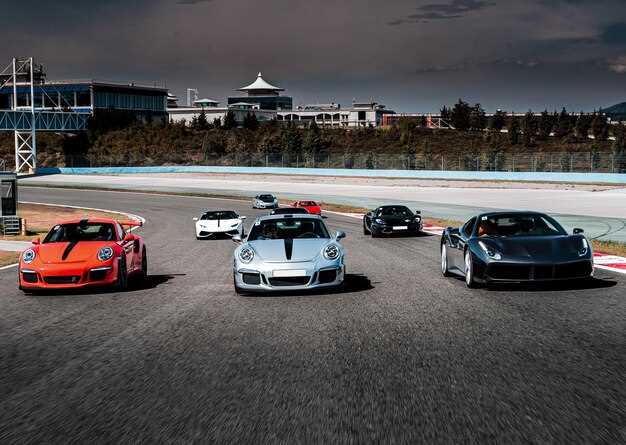
The history of the Porsche Turbo is a testament to the brand’s commitment to innovation and performance. Introduced in the mid-1970s, the Turbo variant of Porsche vehicles transformed the landscape of sports cars, combining power and engineering excellence in a way that had seldom been seen before. The incorporation of turbocharging technology allowed Porsche to push the boundaries of speed and efficiency, defining a new era in automotive performance.
From its inception, the turbocharged models have been at the forefront of Porsche’s lineage, leaving an indelible mark on the automotive industry. With each new generation, the Turbo has evolved, embracing advancements in technology while maintaining the core principles of precision and driving pleasure. This historical overview will explore the key milestones and technological breakthroughs that have shaped the Porsche Turbo legacy, highlighting its significance in both the brand’s history and the wider context of automotive development.
Understanding the Turbo’s evolution provides insight not only into Porsche but also into the broader trends in automotive technology. As the automotive landscape continues to shift, the Porsche Turbo remains a symbol of performance and innovation, celebrating a rich history that has captivated enthusiasts around the globe. Join us as we delve deeper into the remarkable journey of the Porsche Turbo, a vehicle that has consistently redefined what is possible in sports car design and performance.
The Porsche Turbo Legacy: A Historical Overview

The Porsche Turbo lineage began with the introduction of the Porsche 911 Turbo (Type 930) in 1975. This model was revolutionary, featuring a turbocharged flat-six engine that significantly enhanced power while maintaining the classic 911 design. The Turbo quickly became synonymous with performance, setting new benchmarks in the sports car market.
In the 1980s, the Turbo evolved, with advancements such as the introduction of the 911 Turbo (Type 964) in 1989. This version boasted improved aerodynamics and a more refined design, showcasing Porsche’s commitment to engineering excellence. The 964 Turbo also marked the transition to all-wheel drive, enhancing grip and stability.
The 993 Turbo, launched in the mid-1990s, further pushed the boundaries of performance with a twin-turbocharged engine and a sophisticated suspension system. This model is often celebrated for its striking aesthetics and a perfect blend of power and handling. It represented the pinnacle of the air-cooled Porsche era.
The introduction of the 996 Turbo in 2000 marked a new chapter, featuring water-cooled engines and a more modern design language. It provided unprecedented levels of comfort and technology for a Turbo model, attracting a broader audience without sacrificing performance.
As the 21st century progressed, the Porsche Turbo legacy continued with the 997, 991, and most recently, the 992 Turbo. Each iteration has introduced cutting-edge technology, including advancements in turbocharging, hybrid systems, and driver-assistance features while maintaining the essential characteristics that define a Porsche Turbo.
Today, the Turbo models continue to represent the pinnacle of performance in the Porsche lineup, embodying the brand’s relentless pursuit of speed, precision, and innovation. The legacy of the Porsche Turbo is not just about powerful engines but also about the commitment to driving excellence that has captivated enthusiasts for decades.
Key Milestones in the Development of Porsche Turbo Models

The evolution of the Porsche Turbo models is marked by several pivotal milestones that have defined the brand’s history and technological advancements. Each generation has introduced innovative engineering and performance enhancements that have set standards in the automotive industry.
In 1974, Porsche introduced the iconic 911 Turbo (Type 930), which was the first production car to feature a turbocharged engine. This model revolutionized the sports car segment with its distinctive flared fenders and the addition of a rear spoiler to manage airflow and stability. It set the groundwork for future turbocharged innovations within the brand.
Another significant milestone occurred in 1989 with the launch of the 911 Turbo (Type 964), which featured a more refined design and improved aerodynamics. This model employed all-wheel drive for the first time in the Turbo lineup, enhancing traction and performance under various driving conditions.
The introduction of the 911 Turbo (Type 996) in 2000 marked a new era, as it utilized a twin-turbocharged engine, delivering higher power outputs while also being more environmentally friendly. This model showcased the shift towards modern performance metrics and efficiency in turbocharging technology.
In 2016, the 911 Turbo (Type 991) was unveiled, reimagining the Turbo experience with advanced features like adaptive aerodynamics and an upgraded infotainment system. This model epitomized Porsche’s commitment to blending luxurious driving experiences with race-inspired performance.
Each Turbo model reflects Porsche’s dedication to innovation, pushing the boundaries of what a sports car can achieve. The continuous development of these models has not only shaped the history of Porsche but has also influenced the broader landscape of high-performance vehicles around the globe.
The Technological Innovations That Shaped the Turbo Experience
The history of the Porsche Turbo is marked by groundbreaking technological innovations that have continuously elevated the driving experience. One of the most significant advancements was the introduction of turbocharging itself in the 1970s. This technology allowed for increased engine efficiency and power output while maintaining a relatively compact size. Turbocharging enabled the Porsche 911 Turbo to achieve exhilarating speeds, setting new standards in the performance car segment.
In addition to turbocharging, Porsche integrated advanced materials and engineering techniques to enhance performance and reliability. The use of lightweight aluminum and high-strength steel in the vehicle’s construction reduced overall weight while providing structural integrity. This innovation contributed to improved acceleration and handling, essential characteristics for performance enthusiasts.
Another critical development was the application of air-to-air intercooling systems. By cooling the compressed air entering the engine, intercoolers increased density, allowing for greater fuel combustion and improved power delivery. This innovation became a hallmark of the Turbo models and was instrumental in enhancing overall engine performance.
Porsche’s commitment to technological innovation extended to computer-controlled fuel injection systems, which allowed for more precise fuel mapping and optimization. This transition to electronic management systems marked a turning point in the Turbo’s evolution, enabling engineers to fine-tune performance parameters for an unparalleled driving experience. The refined control over fuel and air mixtures translated into smoother acceleration and reduced emissions.
Furthermore, advancements in aerodynamics played a vital role in the Turbo’s development. The iconic “whale tail” spoiler not only provided downforce at high speeds but also contributed to improved stability during cornering. This careful attention to aerodynamic design reflects Porsche’s dedication to enhancing both performance and safety.
Finally, the integration of advanced suspension systems and braking technologies has reinforced the Turbo’s reputation for agility and responsiveness. With the introduction of features like adaptive suspension management and ceramic composite brakes, drivers can experience a tailored performance that adapts to various driving conditions.
In summary, the technological innovations that shaped the history of the Porsche Turbo have not only defined the model but also influenced the broader automotive industry. From turbocharging breakthroughs to cutting-edge materials and systems, each advancement has contributed to a legendary driving experience that continues to captivate enthusiasts around the world.
Impact of Porsche Turbo on Performance Cars and Motorsport
The evolution of the Porsche Turbo has significantly influenced both the landscape of performance cars and the world of motorsport. Since its introduction in the 1970s, the Porsche Turbo has set benchmarks in engineering and design that have resonated throughout automotive history.
One of the primary impacts of the Porsche Turbo on performance cars includes:
- Turbocharging Technology: The introduction of turbocharging by Porsche revolutionized power delivery and efficiency. This technology allowed for smaller engines to produce greater horsepower, setting a precedent for performance vehicles.
- All-Wheel Drive Systems: The Porsche Turbo introduced advanced all-wheel-drive systems, enhancing traction and stability. This feature has since been adopted widely across high-performance cars.
- Aerodynamic Design: The iconic styling and aerodynamics of the Turbo have influenced car design, promoting a focus on reducing drag while increasing downforce. Many manufacturers now emulate Porsche’s design principles in their performance models.
In the realm of motorsport, the Porsche Turbo has left an indelible mark:
- Racing Success: The Turbo’s performance capabilities have led to numerous victories in various racing categories, including endurance racing and rally competitions. Its versatility showcases what a turbocharged vehicle can achieve.
- Inspiration for Competitors: Competitors have been inspired by the Turbo’s success, leading to the development of their own turbocharged models, thus shifting the focus of racing technology.
- Regulations and Standards: The impact of the Porsche Turbo on motorsport has also influenced regulations, as governing bodies have had to adapt to the technological advancements brought forth by turbocharged vehicles.
In summary, the Porsche Turbo has not only defined performance standards but has also played a crucial role in shaping the future of both road cars and motorsport. Its legacy continues to inspire innovation and competition in the automotive world.
 Skip to content
Skip to content





